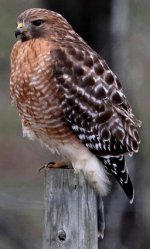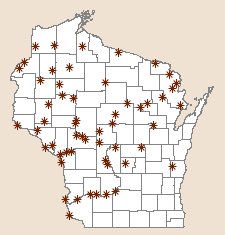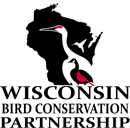- This survey is temporarily discontinued. Check back next year!
- 2010 Annual Report available here

This survey has been temporarily discontinued. Three field seasons have provided preliminary data on distribution, abundance, status, and landscape habitat associations. These data are being analyzed and will be summarized in a study report soon to come. Although exact details are pending results of these analyses, the survey will be conducted at periodical intervals again in the future. If you currently possess any WBCP-owned survey equipment (GPS unit, mp3 player, and/or speakers), please return asap to Ryan Brady, WDNR, 2501 Golf Course Rd., Ashland, WI 54806.
Background / Purpose
The Red-shouldered Hawk (Buteo lineatus) is a Species of Greatest Conservation Need in Wisconsin due to its status as a state Threatened species. However, the distribution, abundance, and trends of this woodland raptor remain unclear in the state because no existing survey adequately monitors its population here, and most studies to date have focused largely on more local scales. In response to these needs, the Wisconsin Bird Conservation Partnership (WBCP) has established a new statewide survey that aims to generate breeding population estimates, monitor trends, inform updated status assessments, and provide habitat management recommendations for this denizen of Wisconsin's mature forests.
What participants can expect
Volunteers conduct two morning surveys of a pre-established route between late March and early May. Routes include 12 stops spaced a mile apart to cover a length of 11 miles. Most occur along roads but those in the Driftless Area of western Wisconsin are river-based and surveyed by canoe or boat. Observers use playback equipment (mp3/CD player and portable speakers) to broadcast Red-shouldered Hawk territorial calls at each 10-minute stop, and surveys generally take ~4-5 hours to complete. See the Protocols document for more details.

© Vic Berardi

This survey provides a fun and bug-free opportunity to soak up the early spring migration of temperate migrants, such as Hermit Thrushes, Ruby-crowned Kinglets, Winter Wrens, Eastern Phoebes, and Yellow-bellied Sapsuckers, or hear the comforting drum of the Ruffed Grouse. Various woodpeckers and other raptors also respond to the Red-shouldered Hawk's territorial call. And because this is a single-species survey, volunteers of all skill levels can easily get involved.
For more information, contact survey coordinator Ryan Brady, Wisconsin DNR, at [email protected] or 715-685-2933.
Results
From 2010-2012, an average of 41 volunteers surveyed 43 routes statewide annually. Each year they detected 110-145 Red-shouldered Hawks (RSHA) on more than half of all survey routes. Detection probability estimates varied from 0.46 in 2010 to 0.78 in 2011, yielding model-adjusted abundance estimates ranging from 2.63 to 3.11 RSHA per route. In general, RSHAs were distributed as expected based on previous data, though densities were surprisingly high in some places. Hotspots included the Lower Wisconsin and Black Rivers in the southwest, various portions of the central sand plains, and Menominee and Marinette Counties in the northeast. For additional details, see the 2010-2012 Summary with a table of results and cumulative map of routes and RSHA observations. Stay tuned for a complete three-year study report soon to come.
Additional Red-shouldered Hawk Survey Links
ATRI Forest Raptors Identification Guide
Red-shouldered Hawk Species Account: Wisconsin All-Bird Conservation Plan
WDNR Species Information: Red-shouldered Hawk
Birds in Forested Landscapes: Red-shouldered Hawk
All About Birds: Red-shouldered Hawk
Conservation Assessment for Red-shouldered Hawk in the North Central States
Bird Studies Canada: Red-shouldered Hawk and Spring Woodpecker Survey
